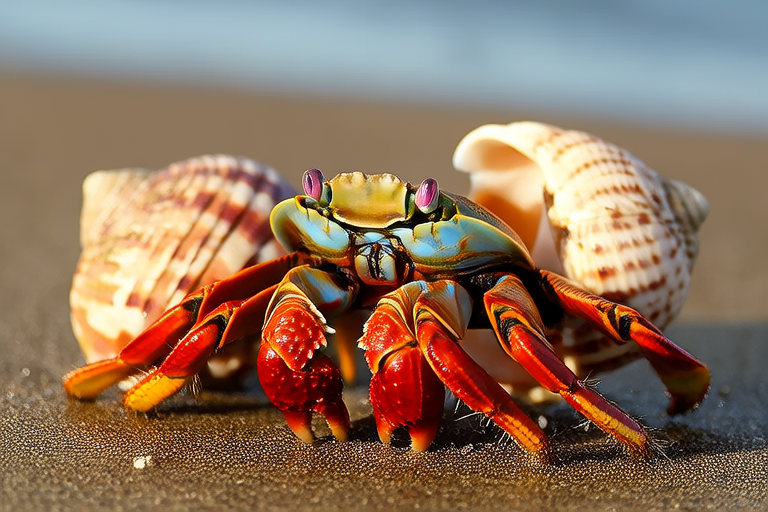How Hermit Crabs Choose Their Shells: A Shell Game You’ve Got to See
Welcome to the fascinating world of hermit crabs! These peculiar creatures have captivated scientists and nature enthusiasts alike with their unique dependency on shells for protection. Unlike most other crustaceans, hermit crabs do not possess a hard exoskeleton that covers their entire bodies. Instead, they rely on second-hand shells, which they scavenge from the ocean floor or steal from fellow hermit crabs.
The Importance of Shells
Shells serve as a vital protective armor for hermit crabs. They shield the soft abdomen of these creatures, which is vulnerable to predators. The shell also acts as a home base for the hermit crab, providing a safe space to retreat when threatened. This dependence on shells makes the shell selection process a crucial part of a hermit crab’s life cycle.
Growing Out of Their Shells
Hermit crabs grow throughout their lives, but their shells remain stationary. As they grow larger, they eventually outgrow their current shell. This is when the search for a new home begins. The timing of this search can vary, but it typically happens when the crab reaches a point where its body no longer fits comfortably within its shell. When this happens, the hermit crab becomes restless, often wandering around in search of a suitable replacement.
The Shell Selection Process
Once a hermit crab has determined that it needs a new shell, it embarks on a quest that involves careful consideration. Size, shape, and weight are all critical factors in this decision-making process. A shell that is too small will not provide adequate protection, while one that is too large may be cumbersome and difficult to carry around. The perfect shell strikes a balance between being spacious enough for the crab’s growing body and lightweight enough for easy transportation.
Shape is another important criterion. Hermit crabs prefer shells that fit snugly around their abdomens, ensuring a tight seal that keeps water inside when submerged. Additionally, some hermit crabs show a preference for certain species of snails, favoring shapes that align with their natural body contours. This ensures that the shell provides optimal protection and comfort.
Weight is also a significant factor. Hermit crabs need to carry their homes with them wherever they go, so a lighter shell is generally more desirable. However, a shell that is too light might lack the necessary strength to withstand attacks from predators. Thus, the hermit crab must find the right balance between portability and durability.
The Shell Swap
The act of swapping shells is both delicate and dramatic. When two hermit crabs meet and realize they have shells of similar sizes, a shell swap can occur. This interaction is often a tense affair, with each crab trying to secure the best possible shell for itself. The larger crab usually gets first dibs, but sometimes smaller crabs manage to outmaneuver their bigger counterparts.
During these exchanges, the hermit crabs carefully inspect each other’s shells. They use their claws to feel the texture and gauge the overall condition of the shell. If both crabs agree that a swap is beneficial, they quickly exchange shells, leaving behind any old shells they may have outgrown. This process is essential for maintaining a healthy population of shells within the hermit crab community.
Modifying the Chosen Shell
Once a hermit crab has found its ideal shell, it doesn’t just move in; it customizes the space to make it even more comfortable. Using its powerful claws, the crab removes any debris or organic matter that might have accumulated inside. It then adds a layer of calcium carbonate, secreted from glands near its mouth, to reinforce the inner surface of the shell. This coating helps protect the crab from parasites and other harmful organisms.
In addition to reinforcing the shell, some hermit crabs also decorate their new homes with bits of seaweed, pieces of coral, or even small rocks. These decorations serve multiple purposes. Not only do they add a personal touch, but they can also help camouflage the crab from potential predators. Some hermit crabs even use these decorations to signal their presence to other members of their species, enhancing communication within the group.
The Role of Shell Availability
The availability of suitable shells plays a critical role in the survival and well-being of hermit crab populations. In areas where shells are scarce, competition for these resources can become fierce, leading to increased aggression among hermit crabs. This competition can result in higher mortality rates due to fights over shells or the inability to find a suitable replacement.
Moreover, the availability of shells is closely tied to the health of the marine ecosystem. When shell-forming organisms like snails and clams thrive, there is a greater abundance of discarded shells for hermit crabs to use. Conversely, when these organisms face threats such as pollution, habitat destruction, or overfishing, the supply of available shells diminishes, putting hermit crab populations at risk.
Conservation efforts aimed at protecting marine habitats and promoting biodiversity are essential for ensuring the long-term survival of hermit crabs. By preserving the ecosystems that support shell-forming organisms, we can help maintain a steady supply of shells for these fascinating creatures.
Conclusion
The world of hermit crabs and their shell selection is a captivating tale of adaptation and resourcefulness. From the moment they outgrow their current homes to the careful consideration of size, shape, and weight, every aspect of this process showcases the ingenuity of these creatures. Watching hermit crabs engage in shell swaps or meticulously modify their chosen shells is truly a spectacle that nature lovers should not miss.
Understanding the importance of shell availability in the ecosystem highlights the interconnectedness of marine life. By supporting conservation efforts and protecting our oceans, we can ensure that future generations have the opportunity to witness the incredible shell game that hermit crabs play.
